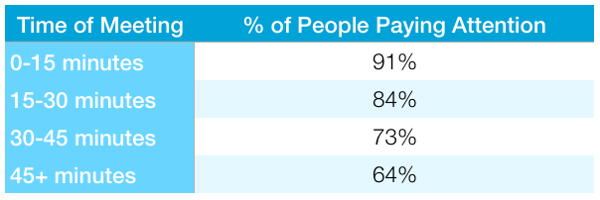
Sales meetings are important for team alignment, making sure that the entire team is working together to meet its targets.
However, it’s easy to miss the mark when conducting meetings. You’ve probably been in one of those meetings that seem to last forever—only to not remember all the points discussed.
Meetings don’t have to be long. In fact, research shows that engagement in meetings starts to drop off quite rapidly after about 30 minutes. Attention levels drop quickly the longer the meeting lasts.

Secondly, meetings have to be productive. It should meet its objectives. Most managers fail to lead a productive meeting simply because they have no system or thought process when conducting meetings.
If you want to maximize every sales meeting and make sure that each team member leaves the meeting more informed, more prepared, and more fired up, follow these 10 steps. Do note though that these 10 points are for your weekly update meetings. If there’s a bigger topic or issue that needs to be discussed, that warrants its own (separate) meeting.
10-Point System for More Productive Meetings

Photo by Austin Distel on Unsplash
Point 1: Prepare an Agenda
Most meetings are structured to discuss problems, important updates, maybe an emergency issue or topic, and then to strategize on the next steps. This is the basic agenda that you will follow week after week.
While there’s a general agenda, you still need to identify the points of discussion for the meeting—essentially the more recent updates, efforts, accounts, targets, and issues—and send these out to the team before the meeting. This gives the members the opportunity to prepare for the meeting. You want people coming to the meeting prepared to avoid having a long, ineffective meeting.
The agenda will serve as an outline for sales reps to follow when preparing their updates or points for discussion. You can even share a presentation with them days before the meeting, and ask reps to add their updates or topics there.
Point 2: Manager Gives Updates
The manager or supervisor should start the ball rolling with his/her updates. These updates will be the team or department’s general status. Highlight new developments, important accounts, successful endeavors, urgent issues and setbacks, etc. The updates should give the members a picture on how the whole team or department is doing and what else needs to be done.
Point 3: Members Give Updates
Each member then gives his/her updates or points. This may be a little tricky as not all members will be as open and honest with their updates. This is why it’s very important to develop a collaborative, transparent culture within the team. Everyone needs to understand that the weekly updates serve to help them meet their goals. This way, they will be more straightforward with their updates.
Make sure that each member is given a time limit when presenting. You don’t want anyone hogging the time.
Point 4: Identify the Most Urgent Points
Some updates will require another separate meeting; other points will need to be addressed on the spot because a) they’re more urgent b) addressing them serves an opportunity to coach (Point #6 below).
Identify those points and discuss them with the team as quickly yet as thoroughly as you can.
Point 5: Strategize
After all the updates are given and the most urgent matters are identified, establish the next steps and goals moving forward. Set team goals and individual goals.
When identifying the next steps, be very specific. For example: “Find out who the Operations Manager for BetterHomes is.”
Point 6: Coach
In sales, there are many moments that can be used as an opportunity to coach or mentor. The weekly meeting is one. While discussing the urgent issues and the next steps that need to be taken, use the opportunity to remind the team of the correct steps, processes, and even attitudes when addressing difficult matters.
Point 7: Acknowledge Wins
The lows should be addressed, but don’t forget the highs. There should be a segment in the meeting where the wins—big and small—are acknowledged and celebrated. Give a shout-out to team members who achieved success in the last week.
A shout-out is not enough though. Quickly explain how the win was achieved. For example: “After a string of unsuccessful emails and calls, Tim decided to use social media to contact prospect. He was able to set a meeting. This is why it’s important to explore multiple touch points. And why it’s also important not to give up easily.”
Point 8: Motivate
Use these wins as an opportunity to motivate. That’s the whole point of sharing and celebrating wins. You want the others to feel inspired and think, “If they can do it, I can do it.”
If, for example, there are no wins that week, you should still find time within the meeting to motivate. It can be something you (the manager or supervisor) experienced or a success story you read somewhere, etc.
Point 9: Recap
Do a recap of the minutes of the meeting. It will also be wise to document and formalize the minutes by emailing them to the team members after.
Point 10: Set Separate Meetings
If there are bigger topics or issues that need to be discussed more thoroughly or if there’s a need to set a coaching or training session for some sales reps, set these meetings immediately after the weekly meeting. This way, you demonstrate an urgency to address these matters.
Main photo by Annie Spratt on Unsplash





